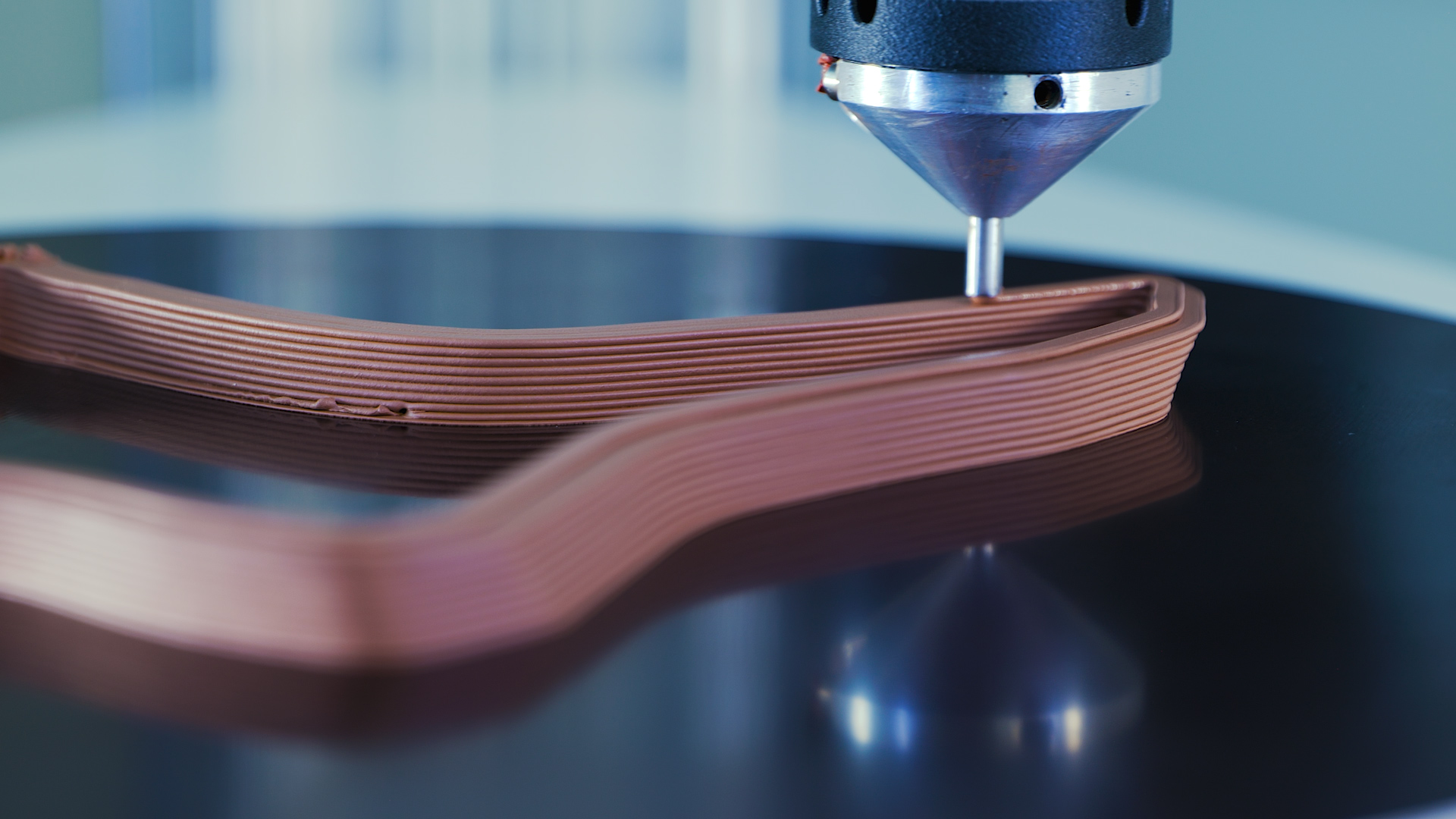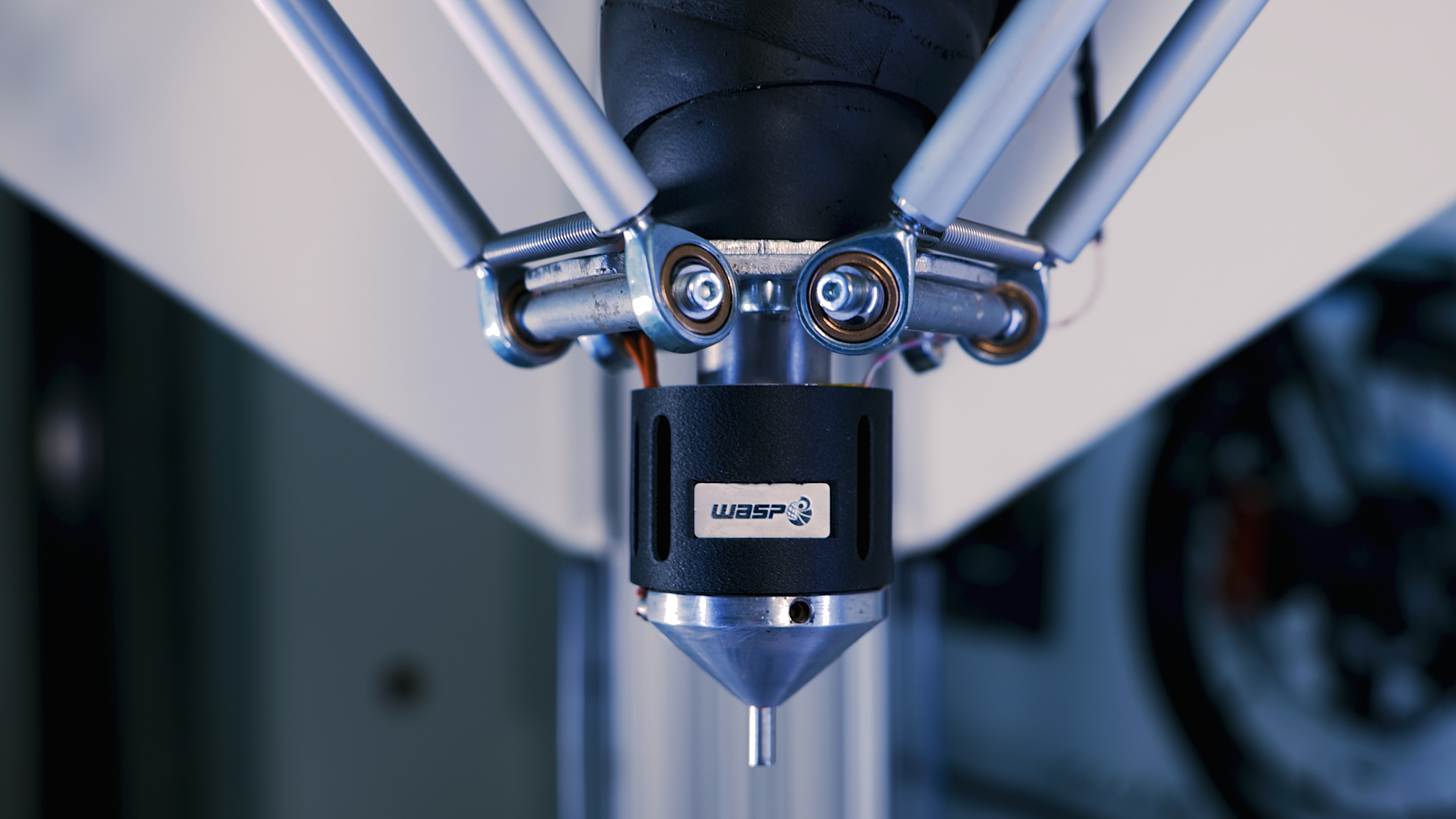After delivering highly publicized 3D printed habitats, helping create commercial drones, and even providing technology for the Italian police to solve crimes, 3D printer manufacturer WASP announced the results of a collaboration with Honda to revolutionize the motorcycle’s industry design process. In April 2021, the automotive giants’ R&D Europe unit teamed up with WASP’s Discover and Development (D&D) specialists to develop a technological process for clay modeling using sustainable industrial 3D printer Delta WASP 40100 Clay. The new concept will offer Honda motorcycle designers an innovative tool to create an industrial model using 3D printed clay that can ultimately be hand-finished. Moreover, since WASP is one of the most sustainable companies in the 3D printing industry, it guarantees that the clay can be reusable.

WASP’s Delta WASP 40100 Clay 3D printer produces motorcycle modelling designs. Image courtesy of WASP.
Bringing the collaborative 3D printing technology into the creative process of industrial clay modeling is at the forefront of the partnership. Both companies have worked to innovate and speed up the industrial development process hoping to offer designers an “unprecedented freedom in manufacturing.” Once the Delta WASP 40100 Clay prints the prototype parts, they can be easily hand-finished and re-worked if they do not meet the required specifications.
Automotive clay sculpting is critical to translate a designer’s vision into a tangible reality, and clay modeling is still commonly used by original equipment manufacturers (OEMs) in the automotive and product design industries. For example, clay models are ideal for companies to visualize the virtual 3D concept design cars and motorcycles.
Honda R&D Europe’s Design Modeling Coordinator Antonio Arcadu describes how industrial clay was first introduced in the design studios thanks to the vision of American designer Harley Earl, who revolutionized the way automobile prototypes were being made in the late 1920s. He is credited with comparing the sculptor’s skills to that of the modeler, highlighted Arcadu, who emphasized Earl’s creative abilities and his role as mediator between designers and engineers.
With broad knowledge ranging from industrial clay modeling and 3D engineering to virtual reality and 3D printing, the modeler figure has become increasingly central to a development project, says Arcadu. In fact, the modeler is responsible for the complete materialization process, starting from the 3D design made entirely in a virtual environment to the final hand-made manufacturing phase, occasionally replaced by the clay milling process or subtractive manufacturing.
“In order to preserve the creative process, we cannot rely on technology alone, but we need modelers not to interrupt their connection with the matter in its most direct form: the hands. Although this is a newly introduced process, it can be considered disruptive in the automotive sector because it introduces a new flow, mostly additive, able to optimize processing times and reduce the amount of material used in the traditional and subtractive processes,” remarks Arcadu.
Since 2017, researchers at WASP D&D have experimented with different types of extrusion for industrial clay, creating a completely innovative approach for the modeling world. However, thanks to the collaboration with Honda and a continuous exchange of know-how, clay extrusion has improved highly, bringing considerable benefits and optimizing the 3D model materialization time.
WASP Co-founder and Product Manager Nicola Schiavarelli described the company’s collaborative 3D printing process as a “new concept in the additive industry.” For its industrial clay 3D printer, WASP further developed its Liquid Deposition Modelling (LDM) technology, which was created for its printers, including the top-selling Delta WASP 2040 and the large size Delta WASP 4060. In addition, for the Delta WASP 40100 Clay, LDM was enhanced to deposit dense fluid heated materials and keeps at a constant temperature the whole system made up of a tank, connection pipe, and extruder.
The technological innovation has a novel extrusion system with a controlled dosing screw that ensures all unwanted air bubbles are removed from the material. According to the company, this high-temperature 3D printer can print directly on the floor or an intermediate removable steel surface and features a metal-sheet frame, which reduces vibrations while providing high stability and print quality.

WASP’s Delta WASP 40100 Clay 3D printer produces motorcycle modelling designs. Image courtesy of WASP.
As in every previous undertaking, WASP engineers continue on a mission to create sustainable 3D printers that rely on locally sourced materials, like clay, a biodegradable and recyclable product that will produce zero-waste structures. For this particular project, WASP and Honda made sure that the industrial clay used throughout the process could be later re-used and re-printed countless times and with minimal waste in a logic of environmental and economic sustainability.
The technology is a tool that will help motorcycle model designers enhance their work. Or like Schiavarelli describes, “a collaboration between humans and machine” and a “new philosophy in 3D printing that becomes circular and collaborative,” driving benefits like cost reduction and less manufacturing time without impacting the labor force. WASP, however, is not stopping at motorcycle design modeling. The business anticipates the technology will be in demand in other fields, such as sculpture, modeling, prototyping, and the world of design.
Subscribe to Our Email Newsletter
Stay up-to-date on all the latest news from the 3D printing industry and receive information and offers from third party vendors.
You May Also Like
3D Printing News Briefs, April 13, 2024: Robotics, Orthotics, & Hypersonics
In 3D Printing News Briefs today, we’re focusing first on robotics, as Carnegie Mellon University’s new Robotics Innovation Center will house several community outreach programs, and Ugogo3D is now working...
Rail Giant Alstom Saves $15M with 3D Printing Automation Software 3D Spark
3D Spark has entered into a three-year deal with the rail giant Alstom. Alstom, a transport behemoth with annual revenues of $16 billion, specializes in the manufacture of trains, trams,...
Meltio Expands Global Reach with New Partnerships in the Americas and Europe
Spanish 3D printing manufacturer Meltio has expanded its sales network across the globe. With the addition of three new partners in the United States, Brazil, Argentina, and Italy, Meltio aims...
3D Printing Webinar and Event Roundup: April 7, 2024
Webinars and events in the 3D printing industry are picking back up this week! Sea-Air-Space is coming to Maryland, and SAE International is sponsoring a 3D Systems webinar about 3D...
































